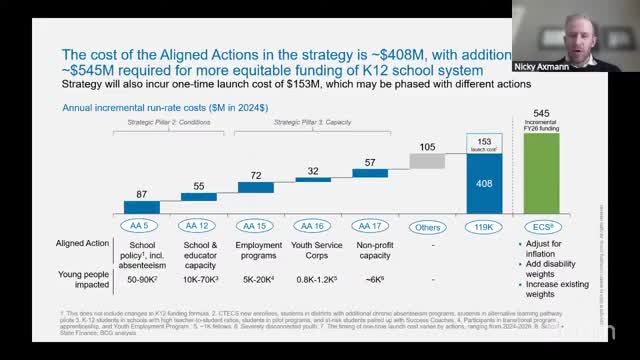Connecticut Commission proposes $545M increase for K-12 funding to address inequities
February 13, 2025 | 2025 Legislature CT, Connecticut
This article was created by AI summarizing key points discussed. AI makes mistakes, so for full details and context, please refer to the video of the full meeting. Please report any errors so we can fix them. Report an error »

Connecticut's education funding landscape is facing critical scrutiny following a recent Joint Informational Forum held by the Education Committee. The meeting highlighted significant disparities in K-12 funding across the state, revealing that while nominal funding has increased by an average of 1.72% annually since 2016, inflation has outpaced this growth at 3.64%. This discrepancy has resulted in an estimated decrease of $400 million in real funding for K-12 education over the same period.
The forum underscored the stark contrast in per-pupil spending among Connecticut's school districts. The ten districts receiving the most state aid average $18,000 per student, while the wealthiest districts spend approximately $32,000 per student. This variation raises concerns about equity in educational resources, particularly for economically disadvantaged students.
A comparative analysis with neighboring Massachusetts revealed that Connecticut contributes only 56% of the total budget for its lowest-income districts, compared to Massachusetts' 75%. This gap in state support is evident across both low and high-income districts, indicating a systemic issue in funding allocation.
In response to these challenges, the commission proposed five key recommendations aimed at reforming the Education Cost Sharing (ECS) formula. These include adjusting the funding formula for inflation, increasing support for economically disadvantaged students, and enhancing funding for multilingual learners and students with disabilities. The proposed changes could lead to an increase of $545 million in annual ECS funding, addressing some of the inequities currently present in the system.
The meeting concluded with a call for further discussion and analysis of these recommendations, emphasizing the need for a more equitable approach to education funding in Connecticut. As the state grapples with these issues, the implications for students and communities remain significant, highlighting the urgent need for reform in K-12 education funding.
The forum underscored the stark contrast in per-pupil spending among Connecticut's school districts. The ten districts receiving the most state aid average $18,000 per student, while the wealthiest districts spend approximately $32,000 per student. This variation raises concerns about equity in educational resources, particularly for economically disadvantaged students.
A comparative analysis with neighboring Massachusetts revealed that Connecticut contributes only 56% of the total budget for its lowest-income districts, compared to Massachusetts' 75%. This gap in state support is evident across both low and high-income districts, indicating a systemic issue in funding allocation.
In response to these challenges, the commission proposed five key recommendations aimed at reforming the Education Cost Sharing (ECS) formula. These include adjusting the funding formula for inflation, increasing support for economically disadvantaged students, and enhancing funding for multilingual learners and students with disabilities. The proposed changes could lead to an increase of $545 million in annual ECS funding, addressing some of the inequities currently present in the system.
The meeting concluded with a call for further discussion and analysis of these recommendations, emphasizing the need for a more equitable approach to education funding in Connecticut. As the state grapples with these issues, the implications for students and communities remain significant, highlighting the urgent need for reform in K-12 education funding.
View full meeting
This article is based on a recent meeting—watch the full video and explore the complete transcript for deeper insights into the discussion.
View full meeting
